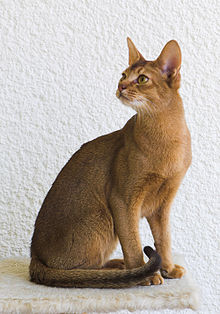Abyssinian cats
| Abyssinian | |
|---|---|

A male ruddy Abyssinian
|
|
| Origin | Indian Ocean coast of Egypt |
| Breed standards | |
| CFA | standard |
| FIFe | standard |
| TICA | standard |
| ACF | standard |
| CCA-AFC | standard |
| Domestic cat (Felis catus) | |
The Abyssinian /æbᵻˈsɪniən/ is a breed of domestic short-haired cat with a distinctive "ticked" tabby coat, in which individual hairs are banded with different colors.
It is named after Abyssinia (now called Ethiopia), the empire from which it was first thought to have originated; more recent research now places its origins somewhere nearer the Egyptian coast. It has become one of the most popular breeds of short-haired cat in the United States.
The Abyssinian cat as it is known today was bred in Great Britain. The name 'Abyssinian' refers to Ethiopia, in reference to widely-spread stories of British soldiers deployed to North Africa in the nineteenth century returning home with kittens purchased from local traders.
The Abyssinian is a slender, fine-boned, medium-sized cat. The head is moderately wedge shaped, with a slight break at the muzzle, and nose and chin ideally forming a straight vertical line when viewed in profile. They have alert, relatively large pointed ears. The notably expressive eyes are almond shaped and are gold, green, hazel or copper depending on coat color. The legs should be long in proportion to a graceful body, with small oval paws; the tail is likewise long and tapering.
Abyssinian kittens are born with dark coats that gradually lighten as they mature, usually over several months. The adult coat should not be excessively short and is ideally fine, dense and close-lying, silky to the touch. The ticked or agouti effect that is the trademark of the breed—genetically a variant of the tabby pattern—should be uniform over the body, although the ridge of the spine and tail, back of the hind legs and the pads of the paws are always noticeably darker. Each hair has a light base with three or four bands of additional color growing darker towards the tip. The base colour should be as clear as possible; any extensive intermingling with grey is considered a serious fault. A tendency to white on the chin is common but likewise must be minimal. The typical tabby M-shaped marking is often found on the forehead.
...
Wikipedia
